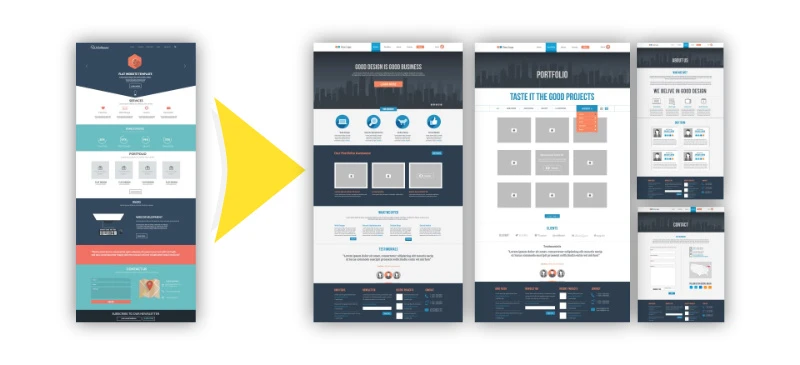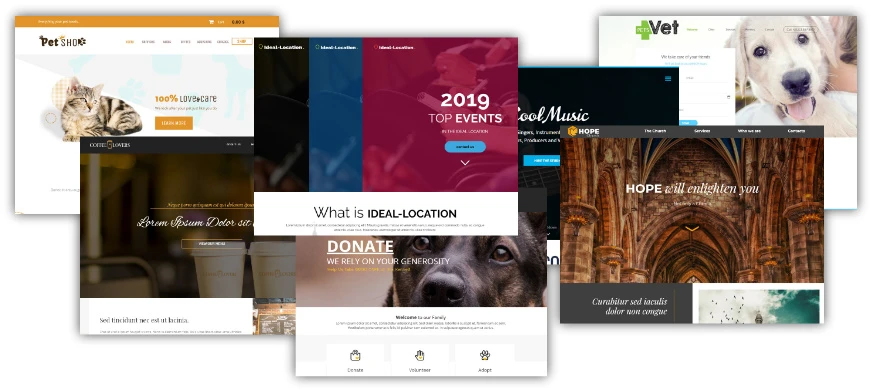One-Page Website: Do you need a single-page website?
Published by Incomedia in Web design · Tuesday 22 Nov 2022
We usually think of a website as a set of pages organized in a tree-like manner, from the main homepage to the content pages. Not all sites, however, are set up this way.

There are also (and in recent years, they’ve become quite popular!) one-page websites, i.e., websites consisting of a single page, generally divided into sections - one after the other - into which all the information you’d like to present to users is condensed.
So, with a one-page site, we don't have an entire page for each menu item, we have a section in a page. And in the navigation menu, each item, has anchor links leading to specific points within the only available page.

It’s easy to see that one-page sites, as a result, are immediate, simple and direct. They’re perfect in situations where you don’t have a lot of content to communicate, and they allow users to quickly find the information they’re looking for.
Think about, for example, a website for a restaurant or pizzeria. When you’re looking online for a place to eat, you don’t need a lot of information. You simply want to know where it’s located, the menu it offers, its prices and the level of quality you can expect. Plus, you’re most likely doing the search from your smartphone. In this type of situation, a one-page website is perfect. With just one scroll, you have all the information you need, you’ll have a positive experience, and the chances that you’ll decide to book a table are proportionally higher.
Single-page websites: advantages and disadvantages
From what we have said so far, it’s easy to highlight the three main advantages of a one-page website:
- Better speed and immediacy
In a one-page website, the information is all there. You don’t need to go from one page to another to find what you’re looking for. There’s not much information, but it’s clear and immediately available. - Lower development and maintenance costs
In the end, you’ll only need to create one page rather than many. Creating your website won’t be so expensive, and you’ll be online more quickly, not to mention the fact that it’ll be easier to keep it updated. - A better navigation experience on smartphones
Vertical scrolling of a one-page site is well-suited for mobile browsing, much better than opening several pages through links in a menu.
Despite these advantages, however, there are some disadvantages to using a one-page website, which are mainly related to positioning and SEO optimization of the page:
- Fewer keywords to compete on
Only a small number of keywords can be included on a single page, and obviously there are fewer elements such as titles and descriptions to work with. - Imbalance of backlinks
Backlinks are links received from the site. From the SEO standpoint, they should be balanced between the various pages of a website, but with a one-page site, you can only put them on the homepage. - Slower loading speeds
In order to include everything, a one-page website stands the chance to become very long, leading to excessive scrolling, but more importantly, it can become quite cumbersome and therefore slow to load, a negative factor, not only in terms of the user experience but also in terms of SEO.
When it’s best to create a one-page website
As we’ve already mentioned, one-page websites are a great choice when you don’t have a lot of content to communicate and when you want to create a relatively simple, yet impactful site on a low budget and in a short amount of time.
This is why one-page websites are the ideal choice for example when you need a showcase site, especially for:
- Small businesses who wish to promote their business online
- Freelancers looking to advertise their services
- Artists, photographers and painters who want to showcase their artistic creations
- Small accommodation facilities like Agritourisms and B&Bs who want to be visible on the internet
- Events, exhibitions and conferences that would like to communicate their agendas and sponsor their events online
- Mini-sites promoting individual products and services created as appendices to larger, more structured websites
Templates for one-page websites
At this point, If you've decided that a one-page website is the best choice for achieving your goals, go for it!
If you are going to fit everything into one page, it’s important that you choose a template that’s divided into sections that will allow you to tell your story while people scroll downward.
Sections that should be included in your website’s template have:
- Your identity - This section is where you take the opportunity to make a good first impression. Include your logo, an image that makes it clear at a glance what you do, a few short sentences that immediately tell who you are and what you offer. In other words, it’s here through a few elements that you’ll clearly introduce yourself to your users in order for them to understand that they’re in the right place, so they can continue to follow you in your narrative.
- Services/offerings - At this point, explain what you do. Try to clearly and concisely detail the highlights of your offer. Your goal is not so much to create a shopping list as to highlight what sets you apart from the competition.
- About us - Here, you have an entire section to introduce yourself. Include a short paragraph explaining as best you can who you are and why people should choose you. Don't forget to include pictures of yourself and/or your team. They’re important as an immediate sign of transparency.
- Portfolio and references - To permanently earn the trust of the reader, it's time to reveal your portfolio, i.e., a selection of your best work. It's important to demonstrate with facts what you can do, and if you have reviews, it's a good time to share them.
- Contact information - At the end, all that remains is to include all your contact information so they can contact you. Some people will prefer to communicate with you via email, some by filling out a form, and others by telephone. Satisfy everyone by opening up as many ways to contact you as possible.
How to create a one-page site
In the eyes of users, a one-page website should be like a little jewel of perfection. As we have seen, for it to be so, you’ll need to start with a good template.
You’ll find many interesting one-page designs on the WebSite X5 Marketplace: PetShop, Ideal-Location, Recording Studio, GoodBoy Foundraising, Hope Church, PetsVet or CoffeeLovers. As you can see, you have an incredible number of choices.
Remember that you can easily customize these templates to meet your needs and your preferences. When that’s done, you can move on to inserting your content, curating your text and carefully choosing your photos, videos and micro animations. All these elements are good for attracting attention and adding emotion by creating just the right atmosphere.
In our Creating a One-Page (single-page) Website guide, we explain how to correctly set up the navigation menu and how to create anchor links.
Eventually all that will be left for you to do is to put your new one-page website online, perhaps simply by taking advantage of the Web Space already included in WebSite X5. You’ll see… it’ll be online sooner than you imagine!


